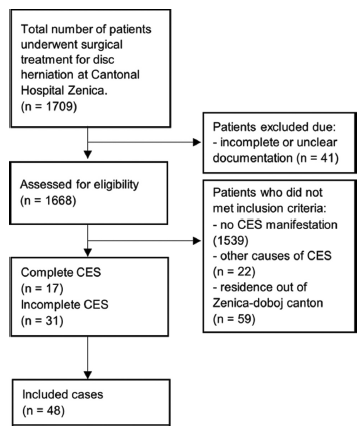Gender-related epidemiological characteristics of cauda equina syndrome caused by disc herniation: a 10-year study in Zenica-Doboj Canton, Bosnia and Herzegovina
DOI:
https://doi.org/10.17532/jhs.2024.2586Keywords:
Gender, neurosurgery, risk, spine, cauda equina syndromeAbstract
Introduction: The unrecognized cases of cauda equina syndrome (CES) and the lack of epidemiological data in Bosnia and Herzegovina about this neurosurgical emergency, including the Zenica-Doboj Canton, contribute to the lack of awareness among health-care professionals, potentially leading to delayed diagnosis and referral for surgical decompression. Aim of this study is to analyze gender-related epidemiological characteristics of CES in Zenica-Doboj Canton in 10 years period.
Methods: The study was conducted in the Zenica-Doboj Canton, and data were obtained from the time period between 2012 and 2022. The study included a total sample of 1709 patients diagnosed with disc herniation who underwent surgical decompression. In total, 48 patients developed CES.
Results: The analysis unveiled noteworthy gender disparities, with male predominance (79.2% vs. 20.8%, p < 0.001) and varying employment distributions (males: 23.7% unemployed, 63.2% employed, 13.1% retired; females: 40.0% unemployed, 20.0% employed, 40.0% retired, p < 0.001). The calculated OR for 2012-2022 was 2.969 (95% CI: 1.576-5.593), signifying a substantial gender-incidence relationship for CES. CES-I incidence ranged 0.80–1.60/100,000 and CES-R ranged 0.25-0.83/100,000. Highest CES incidence was 4.17/100,000 (2015); the lowest was in 2019 with no CES-R cases reported. Male incidence peaked at 2.64/100,000 (2018), and the lowest was 1.06/100,000 (2013, 2017). For females, the highest was 1.17/100,000 (2018, 2021), with no cases reported in certain years. The affected level demonstrated gender differences, with L4/L5 prevalence in males (47.4%) and L3/L4 in females (50%, p = 0.165).
Conclusion: This study revealed a higher incidence of CES in males compared to females in the Zenica-Doboj Canton. The heterogenicity of data regarding CES occurring due to the lumbar disc herniation is significant. This indicates a clear need for additional research and epidemiological studies that would highlight the population of patients that have a higher risk of CES onset.
Downloads

Downloads
Published
License
Copyright (c) 2024 Haso Sefo, Emir Begagic, Hakija Bečulić, Amina Krivić-Džidić, Rasim Skomorac, Fahrduin Alić, Ragib Pugonja, Ermin Hadžić, Igor Sladojević

This work is licensed under a Creative Commons Attribution 4.0 International License.










